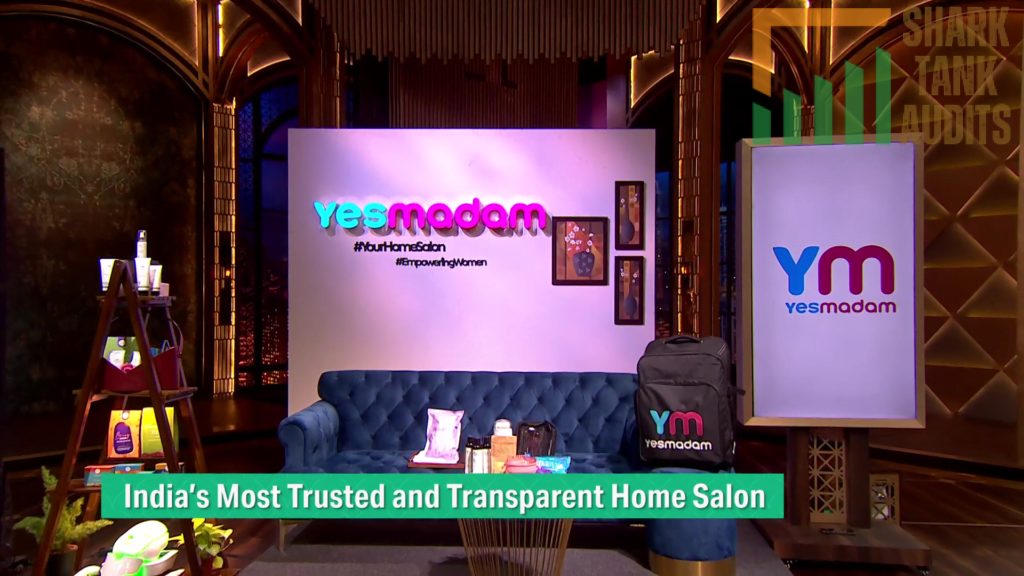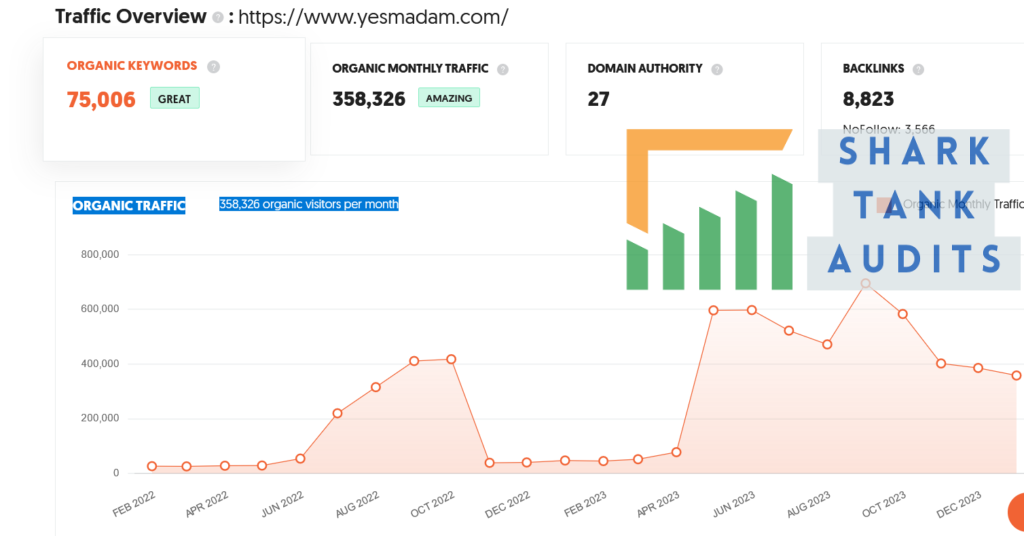Yes Madam Shark Tank India Episode Review
Website Information:
- Website:- Yes Madam
- Built on JavaScript frameworks.
- Boosts Good SEO and work with Microsoft advertising.
- ORGANIC TRAFFIC:- 358,326 organic visitors per month.
Founders:
The Founders are Akanksha Vishnoi, Aditya Arya, and Mayank Arya.
Key Points:
- Yes Madam is a salon-at-home service provider that offers a variety of beauty services like haircuts, facials, waxing, etc.
- The founders of Yes Madam pitched their business on Shark Tank India Season 3, seeking an investment of ₹1.5 crores for a 10% equity stake.
- The sharks were impressed with Yes Madam’s business model and growth potential, but they had some concerns about the company’s profitability and competition from Urban Company.
- Aman Gupta, Peyush Bansal, and Vineeta Singh made offers to Yes Madam, but the founders ultimately decided to go with Peyush Bansal’s offer of ₹1.5 crores for a 15% equity stake.

Detailed Summary:
Yes Madam is a salon-at-home service provider founded in 2016 by Akanksha Vishnoi, Aditya Arya, and Mayank Arya. The company offers a variety of beauty services like haircuts, facials, waxing, etc., at the customer’s doorstep.
The founders of Yes Madam pitched their business on Shark Tank India Season 3, seeking an investment of ₹1.5 crores for a 10% equity stake. They highlighted the company’s strong growth potential, citing India’s large and growing market for beauty services.
The sharks were impressed with Yes Madam’s business model and growth potential. However, they had some concerns about the company’s profitability and competition from Urban Company, a well-established player in the salon-at-home market.
Aman Gupta, Peyush Bansal, and Vineeta Singh made offers to Yes Madam. Aman Gupta offered ₹1.5 crores for a 20% equity stake, Peyush Bansal offered ₹1.5 crore for a 15% equity stake, and Vineeta Singh offered ₹1 crore for a 12% equity stake.
The founders of Yes Madam ultimately decided to go with Peyush Bansal’s offer of ₹1.5 crores for a 15% equity stake. They felt that Peyush Bansal’s experience and expertise in the e-commerce industry would be valuable in helping Yes Madam grow its business.
Conclusion:
Yes Madam’s pitch on Shark Tank India was a success. The company secured an investment of ₹1.5 crores from Peyush Bansal, which will help it expand its operations and reach new customers. Yes Madam is a promising startup that could potentially disrupt the salon industry in India.
Thoughts on the business:
I think Yes Madam has a lot of potential to succeed. The salon-at-home market is a large and growing market, and Yes Madam is well-positioned to capitalize on this growth. The company has a strong team with experience in the beauty industry, and it has a sound business model. I believe that Yes Madam can become a leading player in the salon-at-home market in India.

Yes Madam Shark Tank India Review Website Data
| Category | Information |
|---|---|
| Website | Yes Madam |
| Technology | JavaScript frameworks |
| Digital Advertising | SEO optimization, Microsoft advertising |
| Organic Traffic | 358,326 visitors per month |
| Founders | Akanksha Vishnoi, Aditya Arya, Mayank Arya |
| Business | Salon-at-home beauty services (haircuts, facials, waxing, etc.) |
| Shark Tank India Pitch | Sought ₹1.5 crore investment for 10% equity |
| Sharks’ Impression | Impressed by model and potential, concerned about profitability and competition |
| Aman Gupta | ₹1.5 crore for 20% equity |
| Peyush Bansal | ₹1.5 crore for 15% equity |
| Vineeta Singh | ₹1 crore for 12% equity |
| Final Deal | ₹1.5 crore for 15% equity with Peyush Bansal |
| Conclusion | Secured investment for expansion and growth |
| Potential | Promising startup with potential to disrupt the salon industry |
| Section | Key Point | Data/Metric | Source |
|---|---|---|---|
| Business Potential in India | Market Size (Beauty & Personal Care) | $53.2 billion by 2025 (CAGR 9.13%) | India Brand Equity Foundation |
| Salon Segment Market Size | $10.4 billion (CAGR 14.2%) | India Brand Equity Foundation | |
| Rising Disposable Income | Fuelling demand for premium beauty services | N/A | |
| Convenience Factor | Appealing to busy consumers | N/A | |
| Total Addressable Market (TAM) | Target Audience | Urban women aged 18-55 with $10,000+ monthly income | Nielsen |
| Market Size | Approximately 80 million potential customers | Nielsen | |
| Ideal Target Audience | Demographics | Women aged 25-45 in major Tier 1 & Tier 2 cities | N/A |
| Psychographics | Time-conscious, image-conscious, tech-savvy, convenience-seekers | N/A | |
| Marketing Strategy | Digital Marketing | SEO, social media marketing, influencer marketing, content marketing | N/A |
| App & Website Optimization | Enhance UX, personalize recommendations, offer loyalty programs | N/A | |
| Collaborations | Partner with fashion brands, fitness centers, influencers, co-working spaces | N/A | |
| Referral Programs | Encourage existing customer referrals | N/A | |
| Content & Digital Marketing Strategy | Content Creation | High-quality, engaging tutorials, tips, trends, user-generated content | N/A |
| Targeted Advertising | Reach specific demographics on social media platforms | N/A | |
| Influencer Marketing | Build brand awareness and trust | N/A | |
| SEO Optimization | Ensure easy discoverability | N/A | |
| Distribution Strategy | Mobile App | Focus on seamless booking, service selection, payment, tracking | N/A |
| Website | Offer online booking, service information, promotions | N/A | |
| Partnerships | Collaborate with salons and beauty professionals | N/A | |
| Competitive Advantages | Wide Range of Services | Cater to diverse beauty needs | N/A |
| Qualified Professionals | Ensure quality service and satisfaction | N/A | |
| Technology-Driven Platform | Seamless booking, convenient app, personalized recommendations | N/A | |
| Affordability | Competitive pricing compared to traditional salons | N/A | |
| Challenges | High Competition | Established players like Urban Company & smaller salons | N/A |
| Maintaining Service Quality | Scaling while ensuring consistent quality | N/A | |
| Marketing & Acquisition Costs | Reaching target audience and acquiring new customers | N/A | |
| Customer Trust & Brand Awareness | Building recognition in new service model | N/A | |
| Success Factors | Customer Experience | Exceptional service, personalized recommendations, responsiveness | N/A |
| Technology Investment | Enhance app/website, AI-powered recommendations, streamlined processes | N/A | |
| Strategic Partnerships | Collaborate for new customers and service offerings | N/A | |
| Data-Driven Decision Making | Analyze user data for preferences and personalization | N/A | |
| Mitigation Strategies | Competitive Differentiation | Unique services, flexible booking, attractive pricing | N/A |
| Quality Control Measures | Stringent training, performance evaluations, customer feedback | N/A | |
| Cost-Effective Marketing | Utilize social media, influencer marketing, targeted advertising | N/A | |
| Brand Building Initiatives | Collaborate with influencers, participate in industry events, leverage PR | N/A | |
| Future Roadmap | Service Expansion | Include men’s grooming, wellness, bridal packages | N/A |
| New City Entry | Target Tier 2 & Tier 3 cities with growing demand | N/A | |
| Franchise Model | Partner with local entrepreneurs for wider reach | N/A | |
| Technology Investment | Develop AI-powered chatbots for customer service, recommendations, consultations | N/A | |
| Increasing Valuation | Sustainable Revenue Growth | Focus on customer acquisition, retention, increasing average order value | N/A |
| Profitability | Streamline operations, optimize costs, explore additional revenue streams | N/A | |
| Strong Brand Building | Invest in marketing, PR, brand awareness initiatives | N/A |
Yes Madam: Salon-at-Home Service Provider – Business Plan

1. Business Potential in India:
- Market Size: The Indian beauty and personal care market is estimated to reach $53.2 billion by 2025, growing at a CAGR of 9.13%. The salon segment specifically is valued at $10.4 billion and is expected to grow at 14.2% CAGR. (Source: India Brand Equity Foundation)
- Rising Disposable Income: Increasing disposable income among women, particularly in urban areas, fuels demand for premium beauty services.
- Convenience Factor: Salon-at-home services offer convenience and time-saving benefits, appealing to busy consumers.
2. Total Addressable Market (TAM):
- Urban women aged 18-55 with a disposable income above $10,000 per month. This segment comprises approximately 80 million potential customers. (Source: Nielsen)
3. Ideal Target Audience:
- Demographics: Women aged 25-45 residing in major Tier 1 and Tier 2 cities, working professionals, mothers, homemakers.
- Psychographics: Time-conscious, image-conscious, tech-savvy, convenience-seekers, open to trying new trends.
4. Marketing Strategy:
- Digital Marketing: Focus on SEO, social media marketing (Instagram, YouTube), influencer marketing, and content marketing (blogs, articles, tutorials).
- App & Website Optimization: Enhance user experience, personalize recommendations, and offer loyalty programs.
- Collaborations: Partner with fashion brands, fitness centers, influencers, and co-working spaces for promotions and targeted reach.
- Referral Programs: Encourage existing customers to refer friends and family.
5. Content & Digital Marketing Strategy:
- Create high-quality, engaging content: Tutorials, tips, trends, behind-the-scenes glimpses, user-generated content.
- Utilize targeted advertising: Reach specific demographics and interests on social media platforms.
- Collaborate with relevant influencers: Increase brand awareness and trust among the target audience.
- Optimize website and app for SEO: Ensure easy discoverability through organic search.
6. Distribution Strategy:
- Mobile App: Focus on seamless booking, service selection, payment, and tracking.
- Website: Offer online booking and information about services, stylists, and promotions.
- Partnerships: Collaborate with salons and beauty professionals to expand reach and service offerings.
7. Competitive Advantages:
- Wide range of services: Cater to diverse beauty needs across hair, skin, and nails.
- Qualified and trained professionals: Ensure quality service and customer satisfaction.
- Technology-driven platform: Seamless booking, convenient app experience, and personalized recommendations.
- Focus on affordability: Competitive pricing compared to traditional salons.
8. Challenges:
- High competition: Established players like Urban Company and smaller salons.
- Maintaining service quality: Scaling while ensuring consistent quality across diverse beauty professionals.
- Marketing & acquisition costs: Reaching a targeted audience and acquiring new customers in a competitive landscape.
- Customer trust and brand awareness: Building brand recognition and trust in a relatively new service model.
9. Success Factors:
- Focus on customer experience: Provide exceptional service, personalized recommendations, and timely responsiveness.
- Invest in technology: Enhance the app and website, integrate AI-powered recommendations, and streamline booking processes.
- Strategic partnerships: Collaborate with complementary businesses to reach new customers and expand service offerings.
- Data-driven decision making: Analyze user data to understand customer preferences and personalize marketing efforts.
10. Mitigation Strategies:
- Competitive differentiation: Emphasize unique services, flexible booking options, and attractive pricing.
- Quality control measures: Implement stringent training programs, performance evaluations, and customer feedback mechanisms.
- Cost-effective marketing: Utilize social media, influencer marketing, and targeted advertising efficiently.
- Brand building initiatives: Collaborate with relevant influencers, participate in industry events, and leverage public relations opportunities.
11. Future Roadmap:
- Expand service offerings: Include men’s grooming, wellness services, and bridal packages.
- Enter new cities: Target Tier 2 and Tier 3 cities with growing disposable income and demand for beauty services.
- Franchise model: Partner with local entrepreneurs to expand reach and brand presence.
- Invest in technology: Develop AI-powered chatbots for customer service, personalized recommendations, and virtual consultations.
12. Increasing Valuation:
- Achieving sustainable revenue growth: Focus on customer acquisition, retention, and increasing average order value.
- Profitability: Streamline operations, optimize costs, and explore additional revenue streams.
- Building a strong brand: Invest



